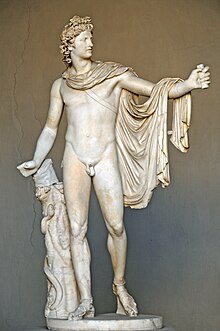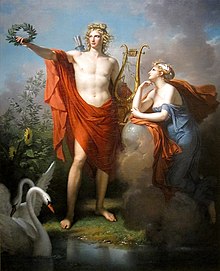
Back Apollo Afrikaans Apollon ALS Apolo (mitolochía) AN أبولو (إله إغريقي) Arabic ابولو ARZ এপ'ল' Assamese Apolu AST Apollon (mifologiya) Azerbaijani آپولون AZB Apollon BAR
| Apollo | |
|---|---|
God of oracles, healing, archery, music and arts, light, knowledge, herds and flocks, and protection of the young | |
| Member of the Twelve Olympians and the Dii Consentes | |
 Apollo Belvedere, c. 120–140 CE | |
| Abode | Mount Olympus |
| Planet | Sun Mercury[1] (antiquity) |
| Animals | Raven, swan, wolf |
| Symbol | Lyre, laurel wreath, python, bow and arrows |
| Tree | laurel, cypress |
| Day | Sunday (hēmérā Apóllōnos) |
| Mount | A chariot drawn by swans |
| Genealogy | |
| Born | |
| Parents | Zeus and Leto |
| Siblings | Artemis (twin), and many paternal half-siblings |
| Children | Asclepius, Aristaeus, Corybantes, Hymen, Apollonis, Amphiaraus, Anius, Apis, Cycnus, Eurydice, Hector, Linus of Thrace, Lycomedes, Melaneus, Melite, Miletus, Mopsus, Oaxes, Oncius, Orpheus, Troilus, Phemonoe, Philammon, Tenerus, Trophonius, and various others |
| Equivalents | |
| Etruscan | Apulu |
| Hittite | Apaliunas |
| Egyptian | Horus |
| Phoenician | Resheph[2] |
| Celtic | Grannus |
| Part of a series on |
| Ancient Greek religion |
|---|
 |

Apollo[a] is one of the Olympian deities in classical Greek and Roman religion and Greek and Roman mythology. Apollo has been recognized as a god of archery, music and dance, truth and prophecy, healing and diseases, the Sun and light, poetry, and more. One of the most important and complex of the Greek gods, he is the son of Zeus and Leto, and the twin brother of Artemis, goddess of the hunt. He is considered to be the most beautiful god and is represented as the ideal of the kouros (ephebe, or a beardless, athletic youth). Apollo is known in Greek-influenced Etruscan mythology as Apulu.[3]
As the patron deity of Delphi (Apollo Pythios), Apollo is an oracular god—the prophetic deity of the Delphic Oracle and also the deity of ritual purification. His oracles were often consulted for guidance in various matters. He was in general seen as the god who affords help and wards off evil, and is referred to as Alexicacus, the "averter of evil".
Medicine and healing are associated with Apollo, whether through the god himself or mediated through his son Asclepius. Apollo delivered people from epidemics, yet he is also a god who could bring ill health and deadly plague with his arrows. The invention of archery itself is credited to Apollo and his sister Artemis. Apollo is usually described as carrying a silver or golden bow and a quiver of silver or golden arrows.
As the god of mousike,[b] Apollo presides over all music, songs, dance, and poetry. He is the inventor of string-music and the frequent companion of the Muses, functioning as their chorus leader in celebrations. The lyre is a common attribute of Apollo. Protection of the young is one of the best attested facets of his panhellenic cult persona. As a kourotrophos, Apollo is concerned with the health and education of children, and he presided over their passage into adulthood. Long hair, which was the prerogative of boys, was cut at the coming of age (ephebeia) and dedicated to Apollo. The god himself is depicted with long, uncut hair to symbolise his eternal youth.
Apollo is an important pastoral deity, and he was the patron of herdsmen and shepherds. Protection of herds, flocks and crops from diseases, pests and predators were his primary rustic duties. On the other hand, Apollo also encouraged the founding of new towns and the establishment of civil constitutions, is associated with dominion over colonists, and was the giver of laws. His oracles were often consulted before setting laws in a city. Apollo Agyieus was the protector of the streets, public places and home entrances.[4]
In Hellenistic times, especially during the 5th century BCE, as Apollo Helios he became identified among Greeks with Helios, the personification of the Sun.[5] Although Latin theological works from at least 1st century BCE identified Apollo with Sol,[6][7] there was no conflation between the two among the classical Latin poets until 1st century CE.[8]
- ^ Price, Fred W. (1994). The Planet Observer's Handbook. New York City, New York: Cambridge University Press. p. 75. ISBN 0-521-78981-8.
- ^ Streck, Michael P. (2008), "Rašap A. In den schriftlichen Quellen", Reallexikon der Assyriologie (in German), p. 253
- ^ Krauskopf, I. 2006. "The Grave and Beyond." The Religion of the Etruscans. edited by N. de Grummond and E. Simon. Austin: University of Texas Press. p. vii, p. 73-75.
- ^ Schmitz, Leonhard (1867). "Agyieus". In Smith, William (ed.). Dictionary of Greek and Roman Biography and Mythology. Vol. 1. Boston: Little, Brown and Company. p. 83. Archived from the original on 14 May 2011. Retrieved 6 June 2008.
- ^ For the iconography of the Alexander–Helios type, see H. Hoffmann, 1963. "Helios", in Journal of the American Research Center in Egypt 2, pp. 117–23; cf. Yalouris 1980, no. 42.
- ^ Cicero, On the Nature of the Gods, § 2.68
- ^ Lucius Annaeus Cornutus, Greek Theology, § 65
- ^ Joseph Fontenrose, "Apollo and Sol in the Latin poets of the first century BC", Transactions of the American Philological Association 30 (1939), pp 439–55; "Apollo and the Sun-God in Ovid", American Journal of Philology 61 (1940) pp 429–44; and "Apollo and Sol in the Oaths of Aeneas and Latinus" Classical Philology 38.2 (April 1943), pp. 137–138.
Cite error: There are <ref group=lower-alpha> tags or {{efn}} templates on this page, but the references will not show without a {{reflist|group=lower-alpha}} template or {{notelist}} template (see the help page).